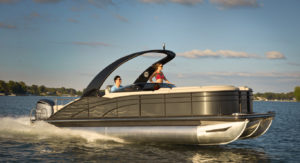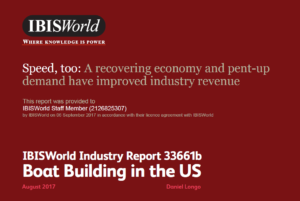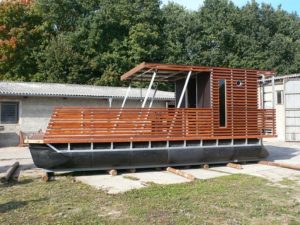
It may not be what we’d innovate, but today’s pontoon boats are innovative. They’re the star of the slowly recovering boat-building market.
It can take effort to sense the silver lining in the dark cumulus clouds of the custom boat business. We work in a mature market, of a discretionary product, for a flat demographic that makes little sense to the next generation. Boats are like golf, but with waves and even crazier names for sh#t. But there’s at least one ray of hope in the thunder clouds of the yacht-making game: Pontoon boats.
Yup, pontoon boats: Floating packages of giant aluminum hot dogs are the runaway winners in the slowly recovering global boat building market, at least according the Boat Building in the US: Market Research Report written by IBISWorld, a global market research firm with offices in New York and Los Angeles.
Pontoon boats find their value through basic ideals just like Spirit-of-Tradition yachts: They mix modern materials with a reasonable willingness to innovate and the courage to create a new kind of boat. Pontoon boat designs are not sophisticated shapes; their hulls are not efficient or sexy, and perhaps they are not the first design direction we would take. But we found them curiously innovative in their own way and pretty darn similar to how we make boats. To learn more, we got the analyst tied to this report on the phone for a chat.
Her name is Iris Peters. And while her research is far from the custom boat building world of our Spirit of Tradition narrative, she’s a professional boat industry watcher with real insight.
Here’s what’s important from the paper:
- An improving, if cooling, boat-building sector. The overall stats for U.S. boat production tell a reasonable, post-recessionary recovery story. IBISWorld estimates there are 810 or so existing boat builders in the U.S. And combined, they did about $10 billion in sales last year. The sector has been growing at about 5 percent since 2010, after the Great Recession decimated this business, along with the rest of the world. Those 800 firms split about $400 million in profit, exporting about $1 billion in product overseas. But, the sector will start to cool soon. Growth should slow to around 1 or 2 percent per year until about 2023. This is what good times in boat building look like.
-

IBISWorld does a nice job summarizing the slowly recovering U.S. boat-building market.
A mature sector that’s still learning things. Boat building is by no means a blow-the-doors-off, world-beater business. It’s very much a stable sector dominated by large players like Beneteau Group or Brunswick Corporation, with each acquiring lines and bringing economies of scale to their production lines. These giants gobbled up the firms that failed to recover from the last downturn. Leaving custom boat yards mostly as independent firms, owned by families. Makers, both big and small, have been investing in new tools or niches to find profits. That all means that making a boat is a bit easier and more lucrative now than it was ten years ago. Not bad.
- New materials and markets make the difference. Peters felt — and this is the important Spirit-of-Tradition part — that today’s successful marine builders all learned the same trick: How to channel new materials and ideas into boats that tell a fresh story to new customers. Peters warned that it’s not an easy step in a global market where it’s “tough to differentiate cost and value.” For example, countries like Mexico may be cheap to build in; but the question remains if the quality is there to get a customer excited. For the record, a lot of the good value in boats seem to be coming from France and Italy, according to Peters.
Let’s innovate with … pontoons.

Interesting, right?
Which leads us to the pontoon thing. IBISWorld believes that the niche that’s doing the best job of bringing new tooling and technologies to new customers are floating platforms of horizontal aluminum pontoons, outfitted with simple fiberglass structures, easy fabrics and powered by plug and play outboard motors. These vessels feature ease of access, lots of comfy seating and plenty of space for bars and cooking and the kids. Did we mention the bars?
Peters says, smart pontoon-boat builders are combining all these materials and ideas in new ways to drastically cut costs and offer vessels that are simpler to us, easier to maintain and more aimed at families with not a lot of time: Get in the car. Head down to the “p-boat.” Motor for 15 minutes. Swim, drink and BBQ, all in a comfy chair, all afternoon. There’s nothing new for husband and wife to fight about. And that gender neutrality is a serious positive for these craft.
And there’s the practical innovation that gives our Spirit of Tradition sector hope: How different is a day on a pontoon boat than a day at a classic boat regatta? How different is the design process of taking a classic Fife or Herreshoff hull and updating it in Kevlar and carbon, than doing the same with aluminum and fiberglass. Both let customers in on the fun of showing up in the new new floating thing. Both are the tools you use on those you love to make memories everybody loves.
It is hard not to be impressed by what innovative pontoon boat makers have been able to do with some aluminum, fiberglass and sun resistant fabrics. And if these companies can do it, so can we. Because, at least macro-economically speaking, this is probably a moment for the Spirit of Tradition to find a moment in the sun.